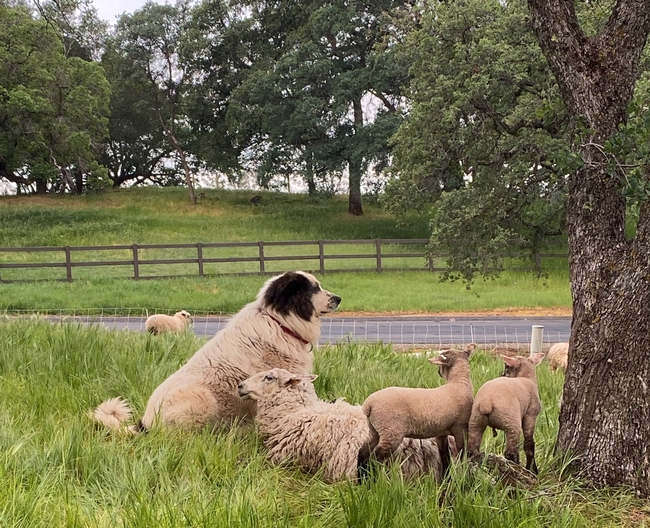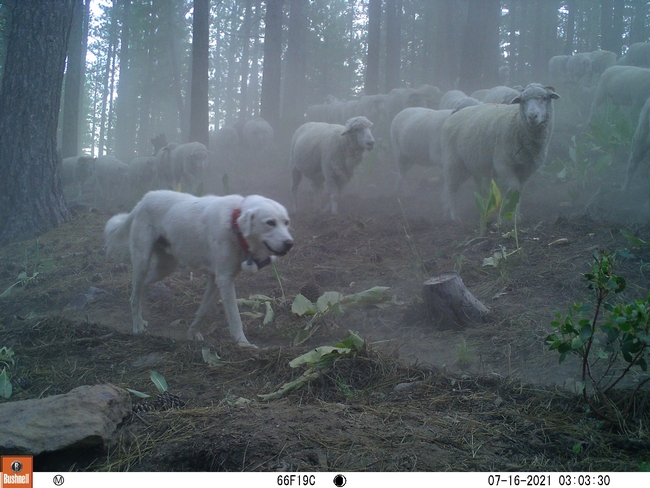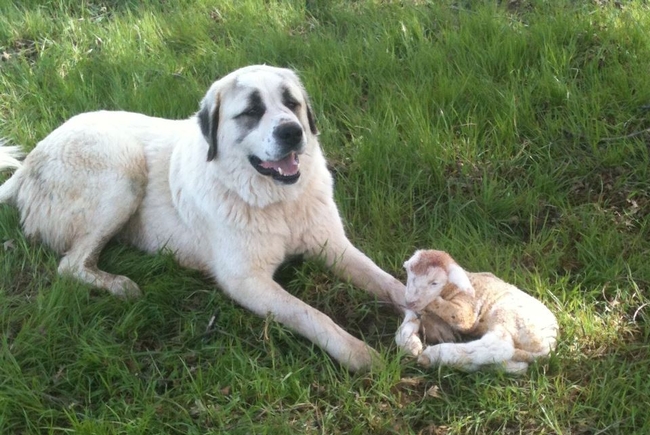- Author: Daniel K Macon
Folks new to the world of working livestock guardian dogs (LGDs), whether they are producers or dog aficionados, often ask, “What's the best breed?” or “What breed is your dog?” I usually begin my answer with a joke: “He's a North American BWD – Big White Dog!” I then go on to explain that all of my successful dogs have usually been a mix of breeds, and that I put more emphasis on the working abilities of my dogs' parents and on desirable phenological traits (like a short coat) than I do on selecting specific breeds. My most recent dogs have all been mixes – Maremma-Anatolian, or Pyrnees-Akbash, for example. And I suspect that most working LGDs here in North America are not purebred – dogs that work in a production setting are also those who get to reproduce, regardless of whether they are purebred. Sometimes this breeding is intentional! A new paper published in iScience sheds light on the varied ancestries of modern livestock guardian dogs.
In “Multiple ancestries and shared gene flow among modern livestock guarding dogs,” the authors generated genome-wide single nucleotide polymorphism (SNP) data from 304 LGDs and combined it with public-genomic data from 2183 modern and 22 ancient dogs. Their analysis suggests shared ancestry and extensive gene flow among modern LGD breeds, which they attribute to historic livestock migrations.
The authors developed genome-wide SNP data from specific LGD breeds extended geographically from the Iberian Peninsula, through Europe, Italy, the Balkans, Western Asia, and Eastern Asia. While much of their analysis goes beyond my very simplistic understanding of genetics, their findings “strongly support the hypothesis that modern LGD breeds from East Asia and the rest of Eurasia are part of two lineages that have evolved independently for millennia.” I find this fascinating – humans who were raising livestock on rangelands in separate regions of the planet looked to dogs as protectors of their livestock! And they developed separate genetic lines with similar physical and behavioral traits!
Transhumance migration – the seasonal movement of people and livestock between high- and lowlands (following the feed) – seems to have played a significant role in the genetic flow between regionally-specificLGD breeds.Transhumance seems to have occurred across many cultures and geographic regions (and still persists today). The nomadic herders of the Mongolian steppes and the open-range sheep outfits of theIntermountain West would recognize eachother's day-to-day work.
Similar to today's Big White Dog breeding strategies, I can imagine multiple family groups taking their sheep and goats along adjacent (or overlapping) migration routes into (and back from) the high country. Perhaps my modern notions of livestock ownership doesn't exactly apply, but I suspect that each family would have tried to keep their livestock separate from the adjacent flocks. But the dogs would have mixed on the margins between these flocks! And they would have reproduced.
In his essay, “Let the Farm Judge,” Wendell Berry describes the powers of observation and adaptation employed by thousands of shepherds over thousands of years on the British Isles that allowed the development of 80 distinct sheep breeds and cross-breeds on a group of islands smaller than California. I can imagine similar observations and adaptations leading to LGD breeds in a transhumance system of livestock production. The dogs that stayed with their flocks – that protected livestock from wolves, brown bears, big cats, other dogs, and even 2-legged human predators – were noted by their owners. And allowed to reproduce – either with other dogs guarding the same flock, or with dogs guarding adjacent herds. If the offspring of these couplings didn't work, they left the gene pool.
The paper notes that reproductive management has not always been intentional in LGD breeds (nor is it today, for that matter). The authors' genetic analyses suggest that there is ongoing gene flow between LGD breeds and free-ranging dogs in specific geographic regions, stating, “Whereas breed clubs and registering bodies forbid dog owners from crossbreeding to dogs from other breeds for the purpose of maintaining traits, such restrictions are not imposed on working landrace populations and, as such, may be challenging to maintain in working dogs frequently left unattended.” In other words, dogs will be dogs – especially LGDs!
Finally, the authors discuss the relatively recent transition of some LGD breeds from working landraces to a registered system of pedigreed pets (notably the Great Pyrenees and Kuvasz breeds). In comparing pet dog genetics with those of working lines, the authors found a higher degree of inbreeding in pet dogs, likely reflective of the use of a handful of popular pedigreed sires.
These last two findings, as the authors indicate, suggest that selecting LGDs for specific guarding behaviors (attentiveness to surroundings, lack of prey drive, or submissiveness to livestock) and other factors (likelihood of roaming, or lack of aggressiveness towards people) may not be entirely (or even mostly) genetically based. In other words, reproductive isolation (that is, only breeding working LGDs to other working LGDs) may not the core mechanism for maintaining the specialized skills of LGDs. Assessing the behavior and performance of a prospective LGD during the puppy selection process becomes even more critical, given these findings – as does the bonding process. While I'm not suggesting that a well-managed bonding process will overcome poorly bred LGDs, this paper seems to confirm that genetics is just one part of a very complicated puzzle! It was a fascinating read!
Coutinho-Lima, D., et al., "Multiple ancestries and shared gene flow among modern livestock guarding dogs." iScience. 110396. August 16, 2024.






